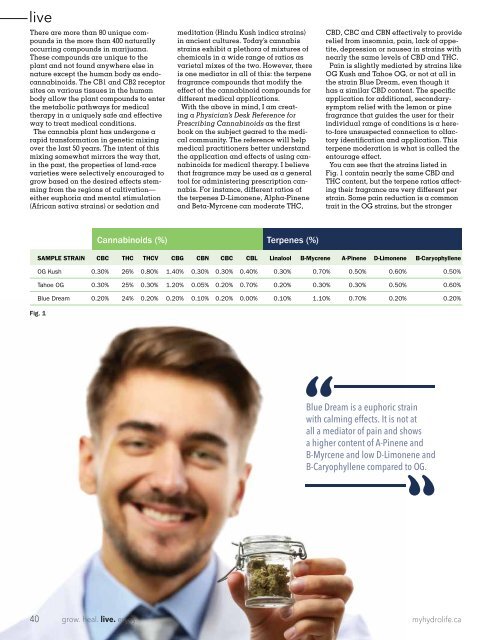Hydrolife Magazine June/July 2016 (CAN Edition)
In the new June/July edition of Hydrolife we explore how, rather than being a gateway, cannabis is actually reducing reliance on opiates used commonly for pain treatment. We also take a look at the many methods that can be employed for using cannabis for pain management. Our Ask a Nurse column provides helpful tips for those considering cannabis, and our writers have gone to great efforts to explain how various strains have different effects and qualities. So in this edition of Hydrolife we invite you to Grow, Live and Heal, but most of all, Enjoy!
In the new June/July edition of Hydrolife we explore how, rather than being a gateway, cannabis is actually reducing reliance on opiates used commonly for pain treatment. We also take a look at the many methods that can be employed for using cannabis for pain management. Our Ask a Nurse column provides helpful tips for those considering cannabis, and our writers have gone to great efforts to explain how various strains have different effects and qualities. So in this edition of Hydrolife we invite you to Grow, Live and Heal, but most of all, Enjoy!
You also want an ePaper? Increase the reach of your titles
YUMPU automatically turns print PDFs into web optimized ePapers that Google loves.
live<br />
There are more than 80 unique compounds<br />
in the more than 400 naturally<br />
occurring compounds in marijuana.<br />
These compounds are unique to the<br />
plant and not found anywhere else in<br />
nature except the human body as endocannabinoids.<br />
The CB1 and CB2 receptor<br />
sites on various tissues in the human<br />
body allow the plant compounds to enter<br />
the metabolic pathways for medical<br />
therapy in a uniquely safe and effective<br />
way to treat medical conditions.<br />
The cannabis plant has undergone a<br />
rapid transformation in genetic mixing<br />
over the last 50 years. The intent of this<br />
mixing somewhat mirrors the way that,<br />
in the past, the properties of land-race<br />
varieties were selectively encouraged to<br />
grow based on the desired effects stemming<br />
from the regions of cultivation—<br />
either euphoria and mental stimulation<br />
(African sativa strains) or sedation and<br />
meditation (Hindu Kush indica strains)<br />
in ancient cultures. Today’s cannabis<br />
strains exhibit a plethora of mixtures of<br />
chemicals in a wide range of ratios as<br />
varietal mixes of the two. However, there<br />
is one mediator in all of this: the terpene<br />
fragrance compounds that modify the<br />
effect of the cannabinoid compounds for<br />
different medical applications.<br />
With the above in mind, I am creating<br />
a Physician’s Desk Reference for<br />
Prescribing Cannabinoids as the first<br />
book on the subject geared to the medical<br />
community. The reference will help<br />
medical practitioners better understand<br />
the application and effects of using cannabinoids<br />
for medical therapy. I believe<br />
that fragrance may be used as a general<br />
tool for administering prescription cannabis.<br />
For instance, different ratios of<br />
the terpenes D-Limonene, Alpha-Pinene<br />
and Beta-Myrcene can moderate THC,<br />
CBD, CBC and CBN effectively to provide<br />
relief from insomnia, pain, lack of appetite,<br />
depression or nausea in strains with<br />
nearly the same levels of CBD and THC.<br />
Pain is slightly mediated by strains like<br />
OG Kush and Tahoe OG, or not at all in<br />
the strain Blue Dream, even though it<br />
has a similar CBD content. The specific<br />
application for additional, secondarysymptom<br />
relief with the lemon or pine<br />
fragrance that guides the user for their<br />
individual range of conditions is a hereto-fore<br />
unsuspected connection to olfactory<br />
identification and application. This<br />
terpene moderation is what is called the<br />
entourage effect.<br />
You can see that the strains listed in<br />
Fig. 1 contain nearly the same CBD and<br />
THC content, but the terpene ratios affecting<br />
their fragrance are very different per<br />
strain. Some pain reduction is a common<br />
trait in the OG strains, but the stronger<br />
Cannabinoids (%) Terpenes (%)<br />
SAMPLE STRAIN CBC THC THCV CBG CBN CBC CBL Linalool B-Mycrene A-Pinene D-Limonene B-Caryophyllene<br />
OG Kush 0.30% 26% 0.80% 1.40% 0.30% 0.30% 0.40% 0.30% 0.70% 0.50% 0.60% 0.50%<br />
Tahoe OG 0.30% 25% 0.30% 1.20% 0.05% 0.20% 0.70% 0.20% 0.30% 0.30% 0.50% 0.60%<br />
Blue Dream 0.20% 24% 0.20% 0.20% 0.10% 0.20% 0.00% 0.10% 1.10% 0.70% 0.20% 0.20%<br />
Fig. 1<br />
Blue Dream is a euphoric strain<br />
with calming effects. It is not at<br />
all a mediator of pain and shows<br />
a higher content of A-Pinene and<br />
B-Myrcene and low D-Limonene and<br />
B-Caryophyllene compared to OG.<br />
40<br />
grow. heal. live. enjoy.<br />
myhydrolife.ca




![Hydrolife Magazine December 2017/January 2018 [CANADIAN EDITION]](https://img.yumpu.com/59790088/1/190x247/hydrolife-magazine-december-2017-january-2018-canadian-edition.jpg?quality=85)
![Hydrolife Magazine December 2017/January 2018 [USA EDITION]](https://img.yumpu.com/59790042/1/190x247/hydrolife-magazine-december-2017-january-2018-usa-edition.jpg?quality=85)
![Hydrolife Magazine October/November 2017 [Canada Edition]](https://img.yumpu.com/59493562/1/190x247/hydrolife-magazine-october-november-2017-canada-edition.jpg?quality=85)
![Hydrolife Magazine October/November 2017 [USA Edition]](https://img.yumpu.com/59493548/1/190x247/hydrolife-magazine-october-november-2017-usa-edition.jpg?quality=85)
![Hydrolife Magazine August/September 2017 [USA Edition]](https://img.yumpu.com/59236656/1/190x247/hydrolife-magazine-august-september-2017-usa-edition.jpg?quality=85)









